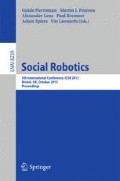Abstract
We investigate whether the SEM model (Self-evaluation maintenance model) can be applied in HRI in relation to psychological safety of a robot. The SEM model deals with social comparisons, and predicts the cognitive mechanism that works to enhance or maintain the relative goodness of the self. The results obtained from 139 participants show that the higher self-relevance of a task is related to a lower evaluation of the robot regardless of actual level of performance. Simultaneously, a higher evaluation of performance relates to higher safety. This study replicates the prediction of the SEM model. In this paper, we discuss the generality of these results.
Access this chapter
Tax calculation will be finalised at checkout
Purchases are for personal use only
Preview
Unable to display preview. Download preview PDF.
References
Kanda, T., Miyashita, T., Osada, T., Haikawa, Y., Ishiguro, H.: Analysis of Humanoid Appearances in Human-robot Interaction. IEEE Trans. on Robotics 24, 725–735 (2008)
Broadbent, E., MacDonald, B., Jago, L., Juergens, M., Mazharullah, O.: Human reactions to good and bad robots. In: Proc. of the IEEE/RSJ International Conference on Intelligent Robots and Systems, San Diego, pp. 3703–3708 (2007)
Muto, Y., Takasugi, S., Yamamoto, T., Miyake, Y.: Timing Control of Utterance and Gesture in Interaction between Human and Humanoid robot. In: Proc. of the IEEE International Symposium on Robot and Human Interactive Communication, Toyama, pp. 1022–1028 (2009)
Kanda, T., Ishiguro, H., Imai, M., Ono, T.: Development and Evaluation of Interactive Humanoid Robots. Proceedings of the IEEE (Special Issue on Human Interactive Robot for Psychological Enrichment) 92, 1839–1850 (2004)
James, W.: The Principles of Psychology. Holt, New York (1890)
Festinger, L.: A Theory of Social Comparison Processes. Human Relations 7, 117–140 (1954)
Thornton, D., Arrowood, A.J.: Self-evaluation, self-enhancement, and the locus of social comparison. Journal of Experimental Social Psychology 2 (suppl. 1), 40–48 (1966)
Tesser, A.: Toward a self-evaluation maintenance model of social behavior. Advances in Experimental Social Psychology 21, 181–227 (1988)
Tesser, A., Millar, M., Moore, J.: Some affective consequences of social comparison and reflection processes: The pain and pleasure of being close. Journal of Personality and Social Psychology 54, 49–61 (1988)
Tesser, A., Campbell, J.: Self-definition: The impact of the relative performance and similarity of others. Social Psychology Quarterly 43, 341–347 (1980)
Pleban, R., Tesser, A.: The effects of relevance and quality of another’s performance on interpersonal closeness. Social Psychology Quarterly 44, 278–285 (1981)
Tesser, A., Campbell, J.: Self-evaluation maintenance and the perception of friends and strangers. Journal of Personality 59, 261–279 (1982)
Kamide, H., Daibo, I.: Application of a Self-Evaluation Maintenance Model to Psychological Health in Interpersonal Context. The Journal of Positive Psychology 4, 557–565 (2009)
Kamide, H., Kawabe, K., Shigemi, S., Arai, T.: A Psychological Scale for General Impressions of Humanoids. In: Proc. of 2012 IEEE International Conference on Robotics and Automation, Saint Paul (2012)
Bartneck, C., Kulic, D., Croft, E., Zoghbi, S.: Measurement instruments for the anthropomorphism, animacy, likeability, perceived intelligence, and perceived safety of robots. International Journal of Social Robots 1(1), 71–81 (2009)
Kamide, H., Kawabe, K., Shigemi, S., Arai, T.: New Measurement of Psychological Safety for Humanoid. In: Proc. of the 7th ACM/IEEE International Conference on Human-Robot Interaction 2012, pp. 49–56 (2012)
Nater, U.M., Rohleder, N., Gaab, J., Berger, S., Jud, A., Kirschbaum, C., Ehlert, U.: Human salivary alpha-amylase reactivity in a psychosocial stress paradigm. International Journal of Psychophysiology 55(3), 333–342 (2005)
Richmond, V.P.: Nonverbal communication in the classroom, 2nd edn. Tapestry Press, Acton (1997)
Ambady, N., Rosenthal, R.: Half a minute: Predicting teacher evaluations from thin slices of nonverbal behavior and physical attractiveness. Journal of Personality and Social Psychology 64(3), 431–441 (1993)
Hartley, J.: Note-taking: A critical review. Programmed Learning and Educational Technology 15, 207–224 (1978)
Atkinson, R.C., Shiffrin, R.M.: Human memory: A proposed system and its control processes. In: Spence, K.W., Spence, J.T. (eds.) The Psychology of Learning and Motivation: Advances in Research and Theory, vol. 2, pp. 89–195. Academic Press, San Diego (1968)
Cunninham, E.G., Wang, W.C.: Using Amos Graphics to Enhance the Understanding and Communication of Multiple Regression. IASE/ISI Satellite Publications (2005), http://www.stat.auckland.ac.nz/~iase/publications/14/cunningham.pdf
Bentler, P.M.: Multivariate analysis with latent variables: Causal modeling. Annual Review of Psychology 31, 419–456 (1980)
Joreskog, K.G., Sorbom, D.: Lisrel 7: A guide to the program and applications. SPSS, Chicago (1989)
Bentler, P.M.: Comparative fit indexes in structural models. Psychological Bulletin 107, 238–246 (1990)
Joreskog, K.G., Sorbom, D.: Lisrel V: Analysis of linear structural relationships by the method of maximum likelihood. National Educational Resources, Chicago (1981)
Cuttance, P.: Issues and problems in the application of structural equation models. In: Cuttance, P., Ecob, R. (eds.) Structural Modeling by Example: Applications in Educational, Sociological, and Behavioral Research, pp. 241–279. Cambridge Univ. Press (1987)
Author information
Authors and Affiliations
Editor information
Editors and Affiliations
Rights and permissions
Copyright information
© 2013 Springer-Verlag Berlin Heidelberg
About this paper
Cite this paper
Kamide, H., Kawabe, K., Shigemi, S., Arai, T. (2013). Social Comparison between the Self and a Humanoid. In: Herrmann, G., Pearson, M.J., Lenz, A., Bremner, P., Spiers, A., Leonards, U. (eds) Social Robotics. ICSR 2013. Lecture Notes in Computer Science(), vol 8239. Springer, Cham. https://doi.org/10.1007/978-3-319-02675-6_19
Download citation
DOI: https://doi.org/10.1007/978-3-319-02675-6_19
Publisher Name: Springer, Cham
Print ISBN: 978-3-319-02674-9
Online ISBN: 978-3-319-02675-6
eBook Packages: Computer ScienceComputer Science (R0)

